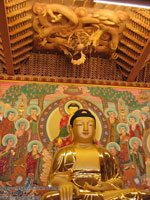Mu Sang Sa (or Gyeryong San International Zen Center) is an international Zen temple where anyone from around the world who is interested in meditation can easily learn about and practice Zen in Korea.
Established in March 2000, Mu Sang Sa supports a community of foreign monks, nuns, and laypeople who want to practice Zen following the teachings of Korean Zen Master Seung Sahn. Many students come to practice or train here and later return to help the Zen Centers in their own countries.

Like many Korean Zen temples, Mu Sang Sa hosts two three-month intensive meditation retreats (Kyol Che) a year, in summer and winter. Koyl Che is a time when one can completely devote oneself to meditation practice away from worldly distractions. At other times of the year, it organizes short weekend retreats and hold weekly Zen Meditation Classes on every Sunday.
Mu Sang Sa is located on Kye Ryong Sahn, a mountain famed for its strong mystical energy in Korea. It sits directly beneath Kuk Sa Bong (National Teacher's Peak), where long ago an eminent master predicted that 800 Great Dharma Teachers would appear to help this world. Other great temples are also located on this mountain, such as Dong Hak Sa, Kap Sa and Shin Won Sa.
Many great Korean Zen Masters, such as Kyong Ho Sunim and Man Gong Sunim have also practiced on Kye Ryong Sahn. Zen Master Seung Sahn carefully viewed many sites over a period of five years before finally choosing the present location at the end of 1998.
What to see
The temple consists of three buildings, the Main Buddha Hall, a Zen Hall and the Residence building. The Zen building has two floors, the first containing eight residential rooms, and the second a large Zen room in which everyone practices together. The Dormitory building has three stories, the first housing a kitchen and dining room, and the other floors, residents' rooms.
In 2004, the 60 pyeong wooden Buddha Hall was completed, with six carved wooden dragonheads on the front, forming an impressive sight.
The Main Buddha Hall, or Dae Ung Jon in Korean, sits on a small rise above the Zen building. It is has an inspiring view of the valley of rice fields below and the mountains in the far distance. The Buddha Hall is clearly visible from the valley and bids an impressive welcome to visitors as they approach Mu Sang Sa.
Inside the Buddha Hall, Sakyamuni Buddha is enshrined in the center, with the Samantabhadra Bodhisattva (Bohyeon Bosal) and the Manjushri Bodhisattva (Munsu Bosal) on each side, forming a triad representing great enlightenment, great action, and great wisdom respectively. On the left wall, there is a painting showing the Amitabha Buddha (Amitabul) and the Western Pure Land on the altar for spirits of the deceased, and just next to this is a memorial altar for Seon Master Seungsahn.
American Zen Master Dae-Bong Sunim, who has stayed at Mu Sang is one of the founding pioneer of Mu Sang Sa. He has been staying at the temple since the very beginning of the construction, practicing and teaching in a run-down prefab house in order to uphold his teacher's wishes
Another American abbot Mu Shim Sunim, who made the most of his more than twenty year's experience living in Korea, constructed the Main Buddha Hall and meticulously carries out various projects around the temple. These two monks received Dharma transmission from their teacher, Zen Master Seung Sahn.
They are well sought after by students who visit Mu Sang Sa.
Address
Mu Sang Sa, Kye Ryong San International Zen Center
452-13, Hyanghan-ri, Eomsa-myeon, Gyeryong-si, Chungnam Prov., 320-917, South Korea.
Tel: 82-42-841-6084 | Fax: 82-42-841-1202 | E-mail: info@musangsa.org



